
Background information
Here’s what you need to know about Samsung’s OLED TV comeback
by Luca Fontana

Almost every year, one is tempted to predict the inevitable end of LG's OLED dominance. At least since Samsung finally stirred up the OLED scene. So far, nothing has come of this prophecy - and that won't change this year either.
Full Disclosure: The TV, the 65-inch version of the G4, was provided to me by LG for testing. I would like to emphasise that I conduct my tests independently and LG has no influence whatsoever on the test result or my evaluation.
A quick recap to start with: LG has been seen as the final opponent to beat in the battle for OLED TV supremacy for years. The South Korean tech giant not only builds OLED TV displays for itself, but also for everyone else. This not only gives it market power, but also a technological advantage.
Since 2022, however, Samsung has also been boasting its own OLED technology: QD-OLED. QD stands for Quantum Dots and refers to the layer that ensures particularly high colour purity. This works so well that manufacturers such as Sony or Alienware are increasingly buying QD OLED displays from Samsung and installing them in their panels.
LG's only option since then has been to move forward. Last year, the TV manufacturer entered the ring with two new improvements:
Together, they form the foundation of Meta Technology. Their purpose is to catch up with Samsung's QD OLED technology. LG would have succeeded in doing this with the G3 last year, at least in my test, hadSony's A95L would not have come out on top in the end with a Samsung QD OLED display in the casing.
This year, LG is launching an improved version of the old principles with the G4: Meta is now called Meta 2.0, is said to have an even better microlens layer and a greatly improved algorithm. Will it be enough for the top position?
The "G" in G4 stands for "Gallery" design. This is because the G4 could hang on the wall in a gallery. The shape of the TV reflects this: it is uniformly thick. In figures: 2.4 centimetres. This is intended (at the time of this review) to create the illusion of a wall painting costing 3499 francs.
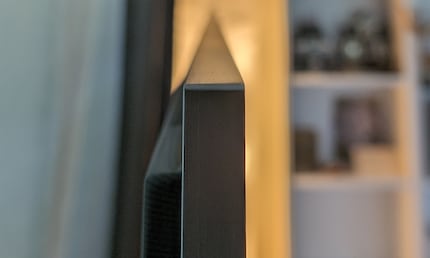
The only problem is if you don't have a wall to hang it on. Or you simply don't want to hang the TV. Fortunately, LG is also supplying a stand this year if you add the version with "G49" in the product name to your cart. Bravo! You could do that before, but it meant an extra charge of around 200 francs. And no: the base price of the G4 has not increased by the same amount. On the contrary. Last year's model, the G3, even cost 3600 francs at the beginning - without the stand.
There is just over eight centimetres of space between the lower edge of the TV and the TV cabinet. That's also more than last year. That's a good thing: This should give most soundbars enough space to be positioned directly under the TV. If the infrared sensor for the remote control is covered by the soundbar, switching the TV on and off becomes a cramp.
Other than that, LG remains true to its "Gallery" design and presents a modern, slim TV with narrow edges and no unnecessary frills. Plus the elegant aluminium frame on the front. At the back, the practical plastic cover plate hides the connections and supports the cable routing to the stand, whose base plate measures around 500×250mm. Viewed from the front, the cables disappear almost without a trace. All in all, a very successful design.
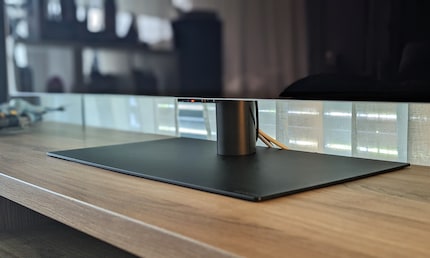
About the specs. LG's G4 offers the following:
All four HDMI inputs support HLG, HDR10 and Dolby Vision. Only HDR10+ is missing. What a pity. But its distribution is very limited anyway: to date, I have only seen isolated HDR10+ content on Amazon Prime Video. The pass-through function for Dolby Atmos and DTS 5.1 audio signals is a very positive feature. You will need this if you use an external device as a player. A UHD Blu-ray player, for example. Unfortunately, I was unable to test whether the pass-through function also works with DTS:X because my soundbar - a Sonos Arc - only supports a maximum of DTS 5.1 Surround.
Another word about the weight. The TV weighs 23.8 kilograms without the stand. If you want to mount the TV on the wall, you will therefore need a VESA 300×300mm mount. You can find this here in our shop. Or you can add a G4 with the designation "G48" in the product name directly to your cart.
What comes next goes deep into the matter. I measure with professional tools from Portrait Display to get an objective categorisation of image quality. If you are not interested in details and diagrams, you can read the following short version and then scroll to the chapter "The image".
The most important findings in brief:
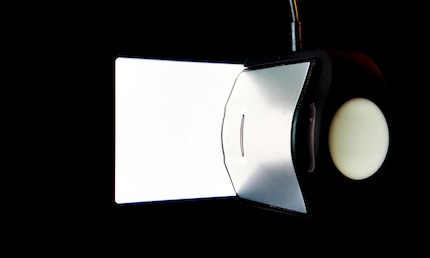
About the measurements. I measured all screen modes of the TV without calibrating it - just as the device comes out of the box. I only made a few changes to the standard settings:
The cinema home mode achieved the best measured values for all types of content. Whether with SDR, HDR or Dolby Vision content. The measurements listed below therefore always refer to this. Except when gaming, for which you should always use Gaming mode.
At the beginning of the year, LG announced its intention to redefine the maximum possible brightness for OLED televisions with its improved Meta 2.0 technology. There was talk of fabulous 3000 nit peak brightness. At least for the 77-inch model. That's almost 1000 nit more than last year - and LCD level. Loose.
Nothing of these fantastic values can be seen in the tested model. However, that sounds more negative than I mean it.
Let's briefly summarise the meta-technology: Thousands of convex microlenses ensure that the light generated by the LEDs is focussed and amplified. The meta-booster, an algorithm, increases the maximum brightness. There is also an additional heat sink and a deuterium composition of the panel that is particularly heat-resistant. This allows the display to shine even brighter without overheating and increasing the risk of burn-in.
LG promised to have analysed large amounts of data on the previous MLA technology and optimised the angle of the lenses. In addition, the Meta 2.0 booster algorithm is said to have become significantly more powerful - also thanks to the new Alpha 11 chipset. Compared to last year's model, the G3, the improvement of around 50 nit in cinema home mode is quite manageable. Nevertheless, the nagging is at a damn high level: LG's G4 shines brighter than Sony's brightest top dog to date. Even if only just.
In contrast, when I measure in "Vivid" mode - the brightest, but by far the worst calibrated mode of the TV - the measuring device even reaches 2226 nit peak brightness. That is significantly more than the 1863 nits I measured last year in the G3's "Vivid" mode. It is quite possible that the 77-inch version of the TV shines even brighter - and thus comes closer to the 3000 nit promised by LG.
Let's take a look at how well LG's new flagship reproduces white, colours and shades of grey. I will answer this in three questions:
Each pixel in the G4 consists of a red, green, blue and white sub-pixel. White is created when they all shine at the same time and with the same intensity. Full brightness produces the brightest white. The lowest brightness, on the other hand, produces the darkest white - i.e. black. In between are shades of grey of varying brightness. This is why the English term "grayscale measurement" is used.
The greater the difference between the brightest and darkest pixels, the better the contrast values. However, I won't bother measuring the contrast because, like all OLEDs, LG's G4 can completely switch off individual pixels. This means that the contrast ratio tends towards infinity.
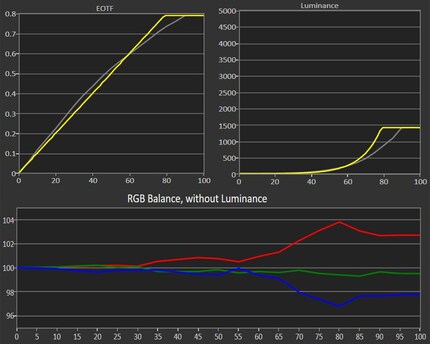
The grayscale measurement of LG's G4 is convincing. The grey tones only deviate slightly from the target value: I measure an average DeltaE of just 1.1 - even if the red component is slightly too high and the blue component slightly too low in lighter grey tones. However, the deviation is hardly visible to the untrained eye. For comparison: Sony's A95L achieved a DeltaE of 2.55 in the Grayscale measurement, while LG's predecessor, the G3, achieved a DeltaE of 3.19.
I measure the coverage of the colour spaces:
The G4 achieves an excellent 96.58 per cent coverage in the important DCI-P3 colour space. This is slightly less than the 98.67 per cent coverage achieved by the G3 last year. Or the 99.78 per cent of the A95L from Sony. But in practice, this makes no visible difference.
In terms of coverage of the very large BT.2020 colour space, LG's OLED TV performs slightly less well at 71.64 per cent. As of today, however, only QD OLED televisions achieve the targeted 90 per cent coverage of the BT.2020 colour space. This is why the film and series industry calibrates its HDR content in the much more widespread DCI-P3 colour space; the extent of BT.2020 coverage is more an indicator of the future suitability of the television.
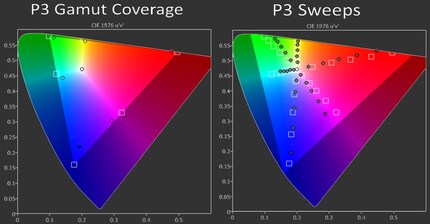
The second question: colour fidelity. This describes how accurately colours are displayed. As with greyscale, the deviation from the TV to the reference value is referred to as DeltaE. The white boxes show the reference colours sent to the TV by the test pattern generator. The black circles, on the other hand, show the colours actually measured.
The measurements are excellent. LG's G4 not only has inherently good colour fidelity in cinema home mode. It's almost reference-worthy! With a total of 40 measured values, I get an average DeltaE of a very good 2.95. This is just below the targeted DeltaE value of 3, at which only professionals can recognise the deviation from a reference monitor with the naked eye. In game mode, the G4 also achieves a very good DeltaE of 3.44.
For comparison: LG's G3 even achieved a DeltaE of 1.97 when measuring colour fidelity. It's a shame that the G4 is slightly above this, even if the difference is difficult to see even for professionals. Sony's A95L, on the other hand, has a DeltaE of "only" 4.16.
Reflections on the screen are not measurable per se. Nevertheless, it is important to address them in tests. For comparison, I'll take a picture from my test with last year's top TV, Sony's A95L. The photos were taken around midday and without any attempt to darken the room.
Both TVs reflect surprisingly little, even during the day. Together with the significantly improved overall brightness compared to previous years, I dare say that both TVs also come into their own in bright rooms.
In the evening, when the room is darker, reflections are no longer a problem anyway. With the Sony TV, however, the slightly purple-coloured reflection of the ambient light can be seen. This is because its QD OLED panel has no polarisation filter to block certain light waves. LG's conventional OLED panel, on the other hand, does. It therefore looks blacker in direct comparison.
Very bright picture. Excellent colour fidelity out of the box and without calibration. In theory. How does it look in practice? I compared LG's G4 with its predecessor, the G3, and last year's top TV, Sony's A95L.
When I want to test a TV for its colour reproduction, I turn to "Guardians of the Galaxy, Vol. 2". This scene in particular: it shows the finest details in the sky without overemphasising them, has that certain punch in the picture that I like so much about OLED displays - with or without "QD" on the front - and Ego's golden palace pops in the saturated evening red. LG's G4 perfectly fulfils the director's intention of capturing the planet's kitschy "Golden Hour".
I particularly like the warm, reddish skin tones, which are a little too yellowish on LG's previous version. With Sony's QD OLED panel, the skin tones in particular look a little more natural. Differences that are only slightly noticeable, however.
Source: Disney+, "Guardians of the Galaxy, Vol. 2". Timestamp: 00:56:47.
To add some variety, I've included a scene from "Avatar: The Way of Water" for testing, where green and especially blue tones dominate. Especially with the bluish skin tone of the nature-loving Na'vi, it quickly becomes apparent that LG's G4 doesn't have the same green tint as its predecessor, but has more dynamic range. Compared to Sony's A95L, the picture looks a little less saturated. However, I almost can't decide whether I actually like LG's picture better for this very reason. A question of taste, I guess.
Source: Disney+, "Avatar: The Way of Water". Timestamp: 00:48:10.
I find it a little easier to pass judgement on "James Bond - Skyfall", when James and the young quartermaster Q look at the picture of a proud old battleship in an art museum, which is ignominiously being towed to the scrapyard. An allusion to the ageing secret agent, of course, but one who still wants to know.
This is where the G4's image convinces me the most - even though LG's G3 definitely looks the most natural. At least if I only look at the skin tones. However, the G4 has a nice, pleasant and warm tone here, which appeals to me personally the most. Sony's A95L follows closely in second place.
Source: Apple TV+, "James Bond - Skyfall". Timestamp: 00:39:02.
How does LG perform in dark scenes? The first scene from "Blade Runner 2049" is used for this test. LG's and Sony's (QD) OLED televisions produce a wonderfully dark picture. If you film against the light, it is normal for details to be "swallowed up" in black silhouettes - known as black crush. The two LG models have more of this than Sony's A95L. Could be intentional. But could also be due to the QD OLED panel.
Source: UHD-Blu-Ray, "Blade Runner 2049". Timestamp: 00:04:50.
A final image test: Detail reproduction in bright image areas. In the following "Jurassic World" example on the G4, pay attention to the sun in the background: even in such a bright image area, the gradations between the individual orange tones in the sky are still so fine that the sun can easily be recognised as a sphere in the firmament. It is precisely in scenes like this that I have set Smooth gradation to "Medium" in the clarity settings for HDR content.
Source: UHD Blu-Ray, "Jurassic World". Timestamp: 00:21:18.
In case you're wondering, I deliberately suppress the smooth gradations in SDR content. When watching football, for example, the green tones in the grass were graded so smoothly that all the details in it were blurred - including the blades of grass! Instead of playing on the grass, the players were suddenly playing on green, smooth surfaces. Unfortunately, I can't show an example because YouTube's licence rules are extremely strict.
The processor is the brain of the TV. Its main task is to receive, process and display image signals. Processing means that the processor recognises poor picture quality and enhances it. It does this, for example, by removing noise, enhancing colours, smoothing edges, making movements smoother and adding any missing pixel information.
At the start, I make it really difficult for the processor. Specifically: Judder, a phenomenon that all TVs have. Especially with long camera pans. Sam Mendes' "1917" is full of such smooth, slowly flowing camera movements and is therefore perfect for the judder test. When making a comparison, pay particular attention to whether the vertical bars in the barn run smoothly through the picture or start to "stutter".
Source: UHD-Blu-Ray, "1917". Timestamp: 00:42:25.
Thanks to the new Alpha 11 processor, LG is once again showing what it's made of this year: there's hardly a trace of Judder to be seen. As a reminder: In the settings under "Clarity", I set the TruMotion setting to "Natural picture" - for me the sweet spot between a smooth picture and a cinema feeling. Sony's processor seems to have a clear preference for the latter: according to Sony, a film must be smooth, even after adjustment in the TV menu. Just like in the cinema, before the digital age. It's still too much jerking for me.
Next scene from "1917". Here, too, Mendes' camera work poses an immense challenge for most processors. Especially with hard edges against a blurred background, for example around the helmets of the two soldiers. Here, both the processor and the pixels have to react incredibly quickly.
Source: UHD-Blu-Ray, "1917". Timestamp: 00:35:36.
Sony's processor - in the third comparison - performs very well, even if it doesn't flex its muscles quite as much as LG's Alpha 11 in the G4 or Alpha 9 in the G3. But that's complaining at a high level: the picture flows, but never looks unnatural.
Next up, the Apple original "For All Mankind". I want to see how long it takes a single pixel to change colour. If this doesn't happen fast enough, it looks to you as if the image is streaking - the effect is called "ghosting". When panning the camera across the surface of the moon, pay attention to the text displayed at the bottom left.
Source: Apple TV+, "For All Mankind", Season 1, Episode 5. Timestamp: 00:00:10.
Problems? Not at all. At least not with LG and Sony, where the superimposed texts always remain sharp. But to give you an idea of what the smearing I'm talking about looks like, I've included a comparison with TCL's C82 model at the end. To be fair, it has to be said that this is a TV that is two years older. The example is therefore for illustrative purposes only. TCL has improved significantly with its successor models since then.
This example also shows the excellent pixel response times that are typical of OLED televisions. This is why they are also considered exquisite gaming monitors. LCD televisions - such as the TCL C82 - are usually at a disadvantage in this respect.
Now the most difficult test. Here I want to see how well the processor upscales less high-quality sources. Blu-rays or good old live television, for example. Or "The Walking Dead". The series was deliberately shot on 16mm film to create the feeling of a broken, post-apocalyptic world with old-fashioned grain and image noise.
Source: Netflix, "The Walking Dead", season 7, episode 1. timestamp: 00:02:30.
LG's Alpha 11 also cuts its usual excellent figure here. As usual, because LG's processors were already particularly good at upgrading inferior sources in previous years. In other words, the picture is sharply defined, pleasantly warm, rich and yet natural. In addition, there is almost no picture noise or compression artefacts. In a three-way comparison with Sony, LG does the better job. You can see this well if you pause the video below and pay close attention to the dark area between the two hostile men.
When measuring the colour accuracy in gaming mode, I achieved an average Delta E of a very good 3.44 (see "White balance, colours and grey tones" above if you are interested in the details of this topic). This is one of the best values I have ever measured in gaming mode on a TV - even better than the G3.
On input lag: With the measuring device from "Leo Bodnar", I measured an average input lag of a very good 9.8 milliseconds with a UHD picture at 60 frames per second and HDR activated. This is also an improvement over LG's G3 with its older Alpha 9 processor. The TV also supports all features relevant for gamers:
To this end, LG - just like Samsung, Sony, Philips, TCL and Panasonic - has entered into a partnership with major gaming studios. The result: HGiG - HDR Gaming Interest Group. According to the manufacturer, this should ensure that HDR is displayed as intended by the game developers. For example, when playing "Spider-Man 2" on my Playstation 5.
Source: PS5, "Spider-Man 2", 120Hz mode, HDR, VRR and ray tracing enabled
What LG conjures up is a feast for the eyes. At a stable 120 frames per second, I swing through the urban canyons at breakneck speed, overpower my opponents in heated battles thanks to barely noticeable input lags or enjoy the liberating glide over the rooftops of New York. Absolutely brilliant colours, perfect contrasts where black really is black, sharp edges and a picture that doesn't smudge even with fast and jerky camera pans round off the picture.
This is what a good gaming mode looks like.
LG has always relied on webOS, which was completely overhauled in 2021 and has since beenand since then has been very reminiscent of the old version of Google TV - not to my delight. The old webOS was simple and sleek. Pressing the home button only opened an app bar at the bottom of the screen. Now a whole window full of tiles opens. This looks full and cluttered, but is now the norm for all manufacturers.
Source: LG webOS 24.
At least with the current version - webOS 24 - LG has dispensed with the annoying and never accurate film and series recommendations at the top. Instead, there are now simply the installed apps.
I rarely scroll any further down. I also hardly ever use the home screen because the most popular streaming services such as Netflix, Disney+ or Prime already have their own button on the remote control. Instead, I simply assign apps such as YouTube or Plex to a number button on the remote control (simply press and hold a number when you are in the corresponding app - voilà, the app is assigned). That way, I only need the home menu to open the app store if I'm still missing an app.
Other than that, navigating through the settings and apps always feels smooth and responsive - thanks to the good processor. Exceptions are the poorly programmed apps from Amazon and Sky. But LG can't help that; the apps run a little sluggishly on all TVs.
The end of LG's older but mature (W)OLED technology still does not seem to have arrived. The South Koreans are making sure of this with the improved version of META technology. This consists of convex microlenses that focus and amplify the generated light and an improved algorithm - the META booster - that increases the maximum brightness at certain points. Together, this results in one of the brightest OLED televisions I have ever tested.
LG also shows its best side in other respects: OLED-typical perfect black levels meet brilliant and accurate colours with remarkably high colour fidelity, straight out of the box and without calibration. Plus a greatly improved processor with excellent upscaling capabilities. A dream of a television, albeit an expensive one.
Pro
Contra
I write about technology as if it were cinema, and about films as if they were real life. Between bits and blockbusters, I’m after stories that move people, not just generate clicks. And yes – sometimes I listen to film scores louder than I probably should.